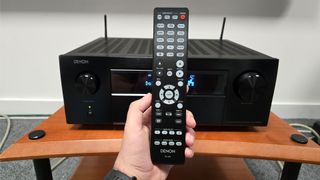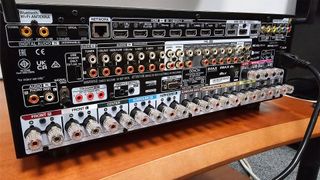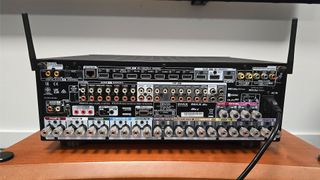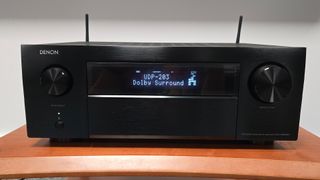Anyone with even a passing interest in home cinema sound will know that a new Denon AV amplifier is exciting news indeed. The AVC-X6800H is the sequel to the What Hi-Fi? Award-winning AVC-X6700H which was released back in 2020; so what has changed in the past (nearly) four years?
While you might not be able to tell much from the outside, Denon is touting an assortment of upgrades under the hood, which means this AVR should outperform its predecessor while also delivering a smoother user experience and enhanced gaming specifications.
That all sounds like a winning combination to us, but can this amplifier deliver the goods in the most important category – sound performance?
Price
Without diving into the intricacies of the global markets, we regret to inform prospective buyers that this year’s iteration of Denon’s flagship X-series AV amplifier is a fair bit more expensive than the previous model. It costs £2999 / $3500 / AU$5999, a considerable leap up from the £2299 / $2499 / AU$6190 that we reviewed the Denon AVC-6700H at in the UK and US. Australia, at least, gets a modest discount.
The good news is that we are already seeing the price drop to around £2800 in the UK. Still, the price of the AVC-X6800H is in line with rival models on the market now. The four-star Pioneer VSA-LX805, for example, offers a comparable feature set for £3099 (around $3900 / AU$6000).
For our testing purposes, however, we are using the Arcam AVR5 for comparison. This amp undercuts the Denon by a fair margin – you can buy it for £1999 / $2000 / AU$3995 at the time of writing. That, though, doesn’t tell the full story; if you want to match the Denon in terms of amplification channels via the Arcam, you will need to purchase the separate Arcam PA410 power amplifier for £1249 / $1650 / AU$3495. Which brings the Arcam package total to a rather more Denon-comparable £3248 / $3650 / AU$7490.
It’s worth noting that in the US this model is an AV receiver (with the model name Denon AVR-6700H), meaning it has a built-in FM tuner. In the UK and Australia it forgoes this feature and is, therefore, an AV amplifier. All other features remain the same, as does – according to Denon – the sound.
Build

If you have seen any Denon AVR released in the past 10 years, this design will be familiar to you. The brushed black metal finish we have in our test room looks neat and understated, although the AVC-X6800H also comes in a dazzling “Premium Silver” finish that looks equally dapper. It measures just 17 x 44 x 38cm (hwd) without the antennae attached, which is pleasingly compact as premium AV amps go. It also weighs just 15.6kg, which is noticeably lighter than the aforementioned Pioneer and Arcam AVR models.

HDMI inputs x 7
HDMI outputs x 3
ARC/eARC eARC
HDMI 2.1 features 4K/120Hz, 8K/60Hz, VRR, ALLM, QMS on all rear HDMI inputs
Amplification 11 channels
HDR formats HDR10, HDR10+, HLG, Dolby Vision
Audio formats Dolby Atmos, Dolby TrueHD, DTS:X, Neural:X, Auro-3D
Streaming HEOS, AirPlay 2, Spotify Connect, Amazon Music HD, TuneIn, Roon Tested, Bluetooth
Voice assistant Compatible with Alexa, Google Assistant, Siri
In terms of notable build features, the AVC-X6800H bears the staple asymmetrical source select and master volume knobs as seen on many other Denon models. They glide with just the right amount of resistance to make finding pinpoint volume levels easy without overshooting. There is also a selection of on-device controls tucked neatly behind a premium-feeling cover that folds down with a satisfyingly weighty motion. Behind this cover, you’ll find quick source select buttons, key navigation buttons, zone power controls and a socket to plug the included calibration set-up mic into, as well as a USB socket.
The remote control is nothing to write home about, but it is functional and responsive – although there is no backlighting, as you find in the Arcam, which would have been useful.
Features

The AVC-X6800H is crammed full of features, as are the step-down AVR-X2800H and AVC-X3800H amplifiers in the current range. Denon claims that this amp can deliver 140W per channel at 8 ohms, or 175W at 6 ohms with two channels driven – the same figures given for the previous generation model. We have no exact figure for power output with all channels driven, but Denon says that all amps in its current range should deliver 70 per cent of the claimed two-channel related power output when running five channels.
The AVC-X6800H features support for 11.4 channels, with preamplifier processing up to 13.4 channels. This means you can use this amplifier with a full 7.4.4 Dolby Atmos surround sound speaker system without the need for an external power amplifier.
Denon has also upgraded connectivity with this new model, making it a better choice for gamers over the AVC-X6700H. You will now find seven full-bandwidth HDMI 2.1 inputs on the rear of the unit (up from just one on the previous model), with three HDMI outputs – one main-zone eARC connector and two additional zones to power speakers in other rooms if you wish to repurpose the assignable surround back and height channels. You’ll also find phono, dual coaxial and dual optical inputs too, as well as a wired network connection and two terminals to screw on the Bluetooth and wi-fi antennae – which takes us nicely onto wireless connectivity.
HEOS (Denon's in-house developed wireless multi-room system) is, of course, included here, accompanied by a handy app to set up the system and play music. Denon is touting an upgraded HEOS AIOS 6.5 module, although it's not entirely clear what that upgrade entails. You’ll also find Spotify Connect and Amazon Music HD connectivity support on the AVC-X6800H, which makes streaming music from either service an absolute breeze. Unfortunately, there is no support for our favourite music service, Tidal, so you will have to rely on Bluetooth if that’s your streaming platform of choice. While it’s not included yet, the AVC-X6800H is also expected to receive Roon Ready certification in an upcoming update.

The seven HDMI inputs are capable of delivering 8K/60Hz or 4K/120Hz video passthrough with VRR, ALLM and the lesser-seen Quick Media Switching feature, making this an ideal amplifier for gamers with a PS5 or Xbox Series X. Movie enthusiasts are also treated to a full suite of HDR format support, with HDR10, HDR10+, Dolby Vision and HLG all on board, as well as the IMAX Enhanced picture mode. Sound format compatibility is equally well serviced, with Dolby Atmos, DTS:X and Auro 3D immersive formats all supported, as well as the more conventional Dolby and DTS surround formats.
Internally, Denon has made several upgrades. It features a monoblock design with upgraded power transistors and a new copper plate for enhanced heat dissipation, as well as a new Griffin Lite XP digital sound processing unit that can also be found in the step-down AVC-X4800H model. Denon has also included a new DAC system, incorporating two ESS Sabre DACs on a dedicated PCB.
Finally, we are pleased to find how easy this AV amplifier is to set up and use thanks to Denon’s intuitive new on-screen menus. The new system menus are clear, easy to read and simple to navigate; most importantly, they put the Arcam’s awkward on-unit display to shame in comparison.
Setting up the Denon involves a quick log-in process and connecting the included microphone to begin the Audyssey calibration process. This is a slightly more involved process than some other AV amp calibration systems as it requires us to move the microphone into different positions around our seating position in order to tailor the sound. The Denon walks us through each step clearly, though. This amplifier also supports Dirac Live for extended room calibration, but that requires both an additional fee and hardware that isn’t included in the box.
Sound

While the Denon looks the part and is packed to the brim with features, it has to sound good in order to earn our seal of approval. We pair the AVC-X6800H with our usual home cinema reference kit, namely the PMC Twenty5.23 and KEF Dolby Atmos toppers in a 7.2.4 arrangement, alongside our Oppo UDP-203 4K Blu-ray player. We are also using a selection of test discs from our library of 4K Blu-rays, including Dune Part One, Oppenheimer and No Time To Die, to test the sonic capabilities.
As soon as the Denon fires up, we are met with a sound that’s akin to coming home to a fresh mug of hot chocolate on a cold winter night – that’s to say it's comforting, rich and warm, but also wholly familiar. Truthfully this bears the markings of Denon's usual sound characteristics so precisely that we could probably stop listening here and tell you practically everything you need to know about how this AV amplifier sounds; but where’s the fun in that?
Starting with Oppenheimer, we learn a great deal about how this amplifier handles dialogue in a scene between the titular scientist and government official Lewis Strauss (played masterfully by Robert Downey Jr.). This Denon delivers vocal performances with excellent clarity while ensuring the character and tonality of each subject are preserved. The rich and detailed performance of the Denon does well to capture subtleties within the actors’ performances, while a bustling party scene later in the film features an encompassing murmur of background voices while keeping the main characters’ dialogue clearly audible.
Moving on to a pulse-pounding scene from the latest Bond that begins in a destructive car chase between Bond and a pair of Range Rovers, the Denon certainly ups the energy – but perhaps not quite as much as its Arcam rival. The Arcam feels more agile as the cars veer and make daring high-speed turns, but the weightier Denon offers enhanced punch when said vehicles are tossed off the dirt road and smashed to pieces in a ditch.
As this scene transitions into a tense chase through a forest with Bond being hunted by henchmen on dirt bikes, we are treated to a seamless surround experience. As the bikes zip by, the rattling of their engines travels organically around our seating position and towards the rear channels in a swift and consistent manner. There are no noticeable gaps in the sound as it makes the move from the front to surround channels, and we can practically pinpoint the sound as it shifts around our AV testing room. The helicopter that soars in during this sequence is also presented with a convincing spatial effect thanks to the Dolby Atmos height channels.

We round out our movie testing with Dune Part One, and this is where the most noticeable differences between the Denon and the Arcam become apparent. The Arcam is the more natural and accurate sounding of the two thanks to its more articulate and balanced nature. It doesn’t sound as warm or rich as the Denon, but it keeps pace with the dramatic worm-attack scene well. The thumping tribal drums that accompany the Atreides’ family outing on the barren planet of Arrakis sound snappy and controlled on the Arcam, with efficiently punchy dynamics; the Denon, however, delivers deeper, more guttural bass, while still remaining composed.
Both amplifiers do an excellent job of building tension within this scene too, with due attention given to low-level dynamics that allows for the slow-building score to develop. When the frantic evacuation of the spice harvester does start, the Arcam offers a more disciplined yet energetic approach, while the Denon’s powerful, gut-punching sound serves up Hans Zimmer’s score with goosebump-inducing flair. There is a greater sense of scale and authority through the Denon and that serves to pull us into the action with more conviction.
We also have the previous Denon model on hand to compare directly with this new version. There are certainly some generational improvements, as the AVC-X6700H is not quite as clear or dynamically punchy as the new AVC-X6800H. However, unless you require the upgraded HDMI sockets, there is no real need to upgrade if you have the X6700H – it is still an excellent home cinema amplifier.
We play some music through the AVC-X6800H using Tidal over Bluetooth and also directly via Spotify Connect, and the results are as to be expected based on the film performance. Everything from Taylor Swift’s yearning Champagne Problems to Fred Again’s thumping electronic hit Delilah (Pull Me Out of This) is delivered with crisp, rich vocals and punchy dynamics. While the timing could be slightly better, the Denon delivers an engaging performance nonetheless.
Hans Zimmer’s Interstellar soundtrack is a prime example of how the warm and rich presentation works in the Denon’s favour. The sweeping orchestral arrangement builds delicately, while the organ bellows with necessary impact.
Denon includes an all-channel stereo mode on this amplifier, and while purists will perhaps want to steer clear, we can appreciate the encompassing, cohesive and bold performance it delivers, even if it sacrifices a touch of attack.
Verdict

Denon has delivered yet another home cinema amplifier that ticks all of our checkboxes. Its bountiful feature set is backed by an intuitive user experience, enhanced HDMI specification for gamers and, most importantly, an impressive sound experience.
This one-box solution for home cinema sound is a product we have no trouble recommending if you want a fuss-free solution to driving your Dolby Atmos home cinema speaker system.
SCORES
- Sound 5
- Build 4
- Features 5
MORE:
Read our review of the Arcam AVR5
Also consider the Denon AVC-X6700H
Read our Denon AVC-X3800H review
Best AV receivers: the top home cinema amplifiers we've tested

